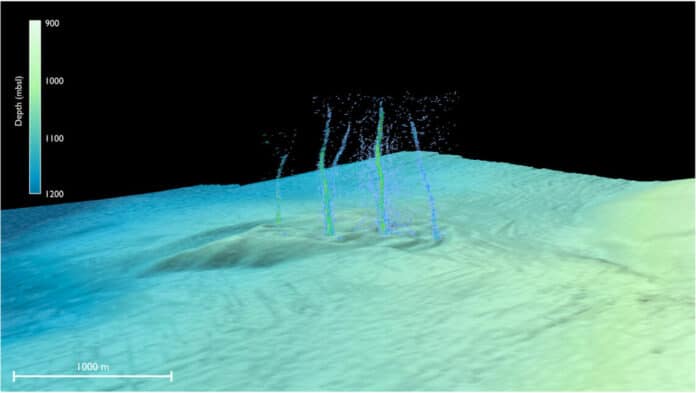Pythia’s Oasis is a newly discovered seafloor seep on the Central Oregon segment of the Cascadia Subduction Zone. In this region, focused venting emits highly altered fluids ~9°C above the background temperature.
A study by the University of Washington discovered seeps of warm, chemically different liquid shooting up from the seafloor about 50 miles off Newport, Oregon. The paper describes Pythia’s Oasis, a special underwater spring the scientists named. According to observations, the spring controls stress on the offshore fault by drawing its energy from water 2.5 miles below the seafloor at the plate boundary.
The discovery was made by the team while the RV Thomas G. Thompson was delayed due to weather. The ship’s sonar detected unexpected bubble plumes around 0.7 miles below the water’s surface. The bubbles were discovered to be merely a minor component of the warm, chemically unique fluid spilling from the bottom dirt after further investigation utilizing an underwater robot.
Co-author Evan Solomon, a UW associate professor of oceanography who studies seafloor geology, said, “They explored in that direction, and what they saw was not just methane bubbles, but water coming out of the seafloor like a firehose. That’s something I’ve never seen and, to my knowledge, has not been observed before.”
According to observations, the fluid leaving the seafloor is 9 degrees Celsius (16 degrees Fahrenheit) warmer than the surrounding seawater. Calculations suggest the fluid is coming straight from the Cascadia megathrust, where temperatures are an estimated 150 to 250 degrees Celsius (300 to 500 degrees Fahrenheit).
Solomon said, “The new seeps aren’t related to geologic activity at the nearby seafloor observatory that the cruise was heading toward. Instead, they occur near vertical faults crossing the massive Cascadia Subduction Zone. These strike-slip faults, where sections of ocean crust and sediment slide past each other, exist because the ocean plate hits the continental plate at an angle, placing stress on the overlying continental plate.”
“The megathrust fault zone is like an air hockey table. If the fluid pressure is high, the air is turned on, meaning there’s less friction, and the two plates can slip. If the fluid pressure is lower, the two plates will lock – that’s when stress can build up.”
“Fluid released from the fault zone is like leaking lubricant. That’s bad news for earthquake hazards: Less lubricant means stress can build to create a damaging quake.”
“This is the first known site of its kind. Similar fluid seep sites may exist nearby, though they are hard to detect from the ocean’s surface. A significant fluid leak off central Oregon could explain why the northern portion of the Cascadia Subduction Zone, off the coast of Washington, is believed to be more strongly locked, or coupled, than the southern section off the coast of Oregon.”
Co-author Deborah Kelley, a UW professor of oceanography, said, “Pythias Oasis provides a rare window into processes acting deep in the seafloor, and its chemistry suggests this fluid comes from near the plate boundary. This suggests that the nearby faults regulate fluid pressure and megathrust slip behavior along the central Cascadia Subduction Zone.”
Journal Reference:
- Brendan Philip, Evan Solomon, et al. Fluid sources and overpressures within the central Cascadia Subduction Zone are revealed by a warm, high-flux seafloor seep. Science Advances. DOI: 10.1126/sciadv.add6688
